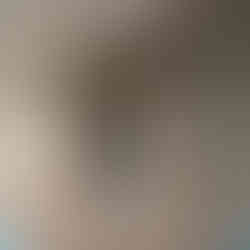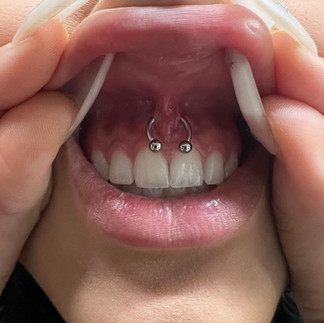To care for your new piercing, always wash your hands thoroughly before touching the piercing to prevent bacteria from causing infections. Clean the piercing twice daily using a saline solution made by dissolving ¼ teaspoon of sea salt in 8 ounces of warm water.
Saturate a cotton swab with the solution, apply it to the pierced area, and let it soak for a few minutes. Then, gently remove any dried matter and rotate the jewelry while the area is wet. Avoid harsh chemicals like rubbing alcohol, hydrogen peroxide, or ointments, and stick to mild antiseptic products such as benzalkonium chloride or diluted antibacterial soap.
Getting a new piercing is an exciting experience, but proper aftercare ensures it heals smoothly and remains free of complications.
This guide provides detailed instructions on how to care for your new piercing in detail.
If you have more questions or need a new piercing, call (905) 897 3503. Our piercer will answer all your questions and provide professional guidance.
General Piercing Aftercare Instructions
Regardless of the type of piercing, these general care instructions apply:
Always wash your hands thoroughly before touching your piercing. Dirty hands can introduce bacteria to the piercing site, increasing the risk of infection.
Do not use rubbing alcohol, hydrogen peroxide, or ointments like bacitracin. These substances can slow the healing process by drying out and damaging healthy cells and preventing oxygen from reaching the wound.
Use a saline solution (¼ teaspoon of sea salt dissolved in 8oz of warm water) for cleaning. Saline solutions help to gently cleanse the area without causing irritation or dryness.
Twice daily, saturate a cotton swab with the saline solution. Apply to the pierced area and let soak for a few minutes to soften any crusted material. Remove any dried matter and gently rotate the jewelry while the area is wet to prevent it from sticking to the skin.
Use mild antiseptic products such as benzalkonium chloride or diluted antibacterial soap. Avoid perfumed products, which can cause irritation and allergic reactions.
Piercing Aftercare Instructions For Specific Body Piercings
Ear Piercing (Lobe and Pinna)
Earlobe piercings generally heal within 6-8 weeks, while piercings on the upper ear (pinna) can take 12-16 weeks due to reduced blood flow. This longer healing time is necessary to ensure the cartilage is fully repaired.
Avoid sleeping on the pierced side and use the non-pierced ear when talking on the phone. Pressure on the new piercing can irritate and delay healing.
Follow the general cleaning routine. Be extra gentle with the upper ear to prevent irritation. Due to their location, cartilage piercings are more prone to complications like keloids and infections.
Belly Button and Nipple Piercings
Belly button piercings can take 6-12 months to heal, while nipple piercings usually heal within 6-8 weeks. These areas are more susceptible to irritation from clothing and movement.
For saltwater soaks, create a suction seal between a cup filled with saline solution and the pierced area. Lie down and soak the area for at least 10 minutes to ensure thorough cleaning and hydration. Rinse with plain water and dry thoroughly to prevent moisture from promoting bacterial growth. Alternatively, use salt water-soaked cotton swabs to clean the area. This method is especially useful if soaking is impractical.
Wear loose-fitting clothing to avoid irritation. Tight clothing can rub against the piercing, causing discomfort and delaying healing.
Nose Piercings
Nose piercings can take 12-24 weeks to heal, depending on the location of the piercing. Septum piercings, for example, may heal faster than nostril piercings due to their placement.
Do not remove the stud for at least 8 weeks to prevent the piercing from closing. Nose piercings can close very quickly, especially in the early stages of healing.
Follow the general cleaning routine and avoid unnecessary touching. The inside of the nose is particularly susceptible to bacteria, so maintaining cleanliness is crucial.
Oral Piercings (Tongue, Cheek, and Lip)
Oral piercings take 6-8 weeks to heal. The mouth is a moist environment, which can promote faster healing but also increases the risk of infection.
Avoid oral contact (kissing, oral sex) for 6 weeks to prevent introducing bacteria to the piercing. Use ice or popsicles to reduce swelling during the first 24-48 hours. Cold compresses can also help manage pain. Rinse with a mild mouthwash or saline solution after eating or drinking anything other than water to keep the area clean.
Use Gly-Oxide or Peroxyl twice daily as per instructions to help clean and disinfect the piercing. Clean the outer opening with liquid antibacterial soap diluted 50/50 with water for cheek and lip piercings. Avoid perfumed products that can irritate the skin.
Genital Piercings
Generally, it takes 6-10 weeks, though some may take longer depending on the individual's healing rate and the type of piercing.
Use warm water with a mild antibacterial soap (e.g., Phisoderm, Bactine). Avoid perfumed products, which can irritate. Apply the cleanser and gently work the jewelry through the piercing to ensure thorough cleaning. Rinse thoroughly with water, using a peri-cleanse bottle if necessary, to remove all soap.
Avoid sexual contact until fully healed. Use barriers (condoms, dams) to protect the piercing from bodily fluids that can introduce bacteria.
Additional Tips
Wear loose-fitting clothing over piercings to prevent irritation. Tight clothing can trap moisture and bacteria, increasing the risk of infection.
Avoid swimming until the piercing is fully healed to reduce the risk of infection from contaminated water. Chlorinated pools, hot tubs, and natural bodies of water can all harbour harmful bacteria.
Look for signs of infection, such as redness, swelling, pus, or pain. If any of these occur, seek medical advice promptly. Early treatment can prevent more serious complications.
What to Expect as Your New Piercing Heals
Your piercing will heal in phases, and you will notice different symptoms during each phase.
Initial Healing Phase
The initial healing phase lasts from a few days to a few weeks. During this time, it is common to experience swelling as your body reacts to the new piercing. The area around the piercing may appear red and feel tender due to the trauma of the needle passing through the tissue. Minor bleeding can also occur, especially within the first few days. This is a normal part of the body's response to the piercing.
Intermediate Healing Phase
The intermediate healing phase typically spans from the end of the initial phase up to several months, depending on the piercing location. During this period, the body forms new tissue around the jewelry.
You may notice that the initial symptoms, like swelling and redness, gradually subside. However, occasional discomfort or itching can occur as the healing process continues. A whitish-yellow fluid, not pus but a normal secretion called lymph, might be seen around the piercing. This is part of the healing process and helps to keep the area clean.
Late Healing Phase
The late healing phase can last several months to a year, again depending on the location of the piercing. At this stage, the new tissue around the jewelry strengthens and stabilizes. The piercing should feel more comfortable and less tender. It's important to note that even if the exterior appears healed, the internal tissue might still be in the process of healing. Any trauma or irritation during this phase can cause setbacks in the healing process.
Full Healing
Full healing is reached when the piercing no longer exhibits tenderness, discharge, or redness. This can take a few months to over a year for many piercings. It's important to be patient and continue following proper aftercare practices until the piercing is fully healed internally and externally.
Xtremities Tattoo & Piercing Studio Offers Piercing Services in Mississauga
Xtremities Tattoo & Piercing Studio, the longest-running studio in Mississauga, is renowned for its less painful piercing services. Conveniently located on Dundas Street, just west of Hurontario Street, our piercing studio offers a wide range of piercing options performed by highly skilled and experienced piercers.
Trained personally by Steven, the owner, our piercers ensure a safe and less painful experience. We use only surgical steel jewelry to minimize the risk of complications. Open seven days a week, Xtremities provides a welcoming and professional environment for all your piercing needs. Visit us today for an unparalleled piercing experience.
Call (905) 897 3503 for new piercings in Mississauga, Ontario.
FAQs
How should I take care of a new piercing?
To take care of a new piercing, clean it twice daily with a saline solution or an antiseptic solution recommended by our piercer. Avoid touching the piercing with dirty hands, and refrain from rotating the jewelry. Ensure you follow all aftercare instructions our piercer provides to prevent infections and promote healing.
What not to do after getting a piercing?
After getting a piercing, do not touch or twist the jewelry with unwashed hands, as this can introduce bacteria and cause infections. Avoid submerging the piercing in pools, hot tubs, or other bodies of water. Do not apply alcohol, hydrogen peroxide, or ointments, as these can irritate the piercing and hinder healing.
How soon after getting a piercing should you clean it?
You should start cleaning your new piercing within a few hours after getting it. Clean it twice daily using a saline solution or a piercing-specific cleanser to keep the area free from bacteria and promote healing.
What is the best solution for piercing aftercare?
The best solution for piercing aftercare is a sterile saline solution. This solution is gentle on the skin and helps to keep the piercing clean without irritating. Some piercers may also recommend a mild, fragrance-free antibacterial soap.
What helps piercings heal the fastest?
To help piercings heal the fastest, maintain a consistent cleaning routine using a saline solution, avoid touching the piercing with dirty hands, and keep the area dry and free from irritation. Eating a balanced diet and staying hydrated can also support the body's natural healing process.
When to stop using saline on piercings?
You should continue using saline on piercings until they are fully healed, which can take several months to over a year, depending on the piercing location. Once there are no signs of tenderness, discharge, or redness, you can gradually reduce the frequency of saline use.
Can you use Q-tips to clean piercings?
You can use Q-tips to clean piercings, but ensure they are sterile and used gently to avoid causing trauma to the piercing site. Be careful not to leave any cotton fibres behind, as they irritate the piercing.
Can I clean my piercing with just water?
While cleaning your piercing with just water can help remove some debris, it is not sufficient for proper aftercare. Use a saline solution or a recommended antiseptic to effectively clean and disinfect the piercing.
What is a good substitute for saline solution for piercings?
A good substitute for saline solution for piercings is a mixture of sea salt and distilled water. Mix 1/4 teaspoon of non-iodized sea salt with 8 ounces of warm distilled water to create a gentle cleansing solution for your piercing.














Comments